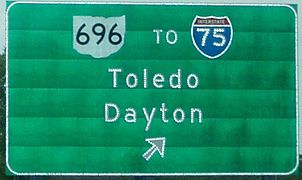Button copy

Button copy is a deprecated physical design of road signs in the United States. Round plastic retroreflective buttons made of transparent plastic are placed in rows following the contours of sign legend elements, usually painted white, such as letters, numbers, arrows, and borders. In daylight, the buttons visually blend with the white sign legend elements and so are minimally conspicuous. At night, light from each approaching vehicle's headlamps strikes the retroreflective buttons and is reflected back towards the eyes of the vehicle's driver. Thus the sign is made sufficiently conspicuous and legible for adequately fast and accurate recognition and interpretation by drivers.
Button copy is no longer manufactured; technologically it has been supplanted by retroreflective sheeting made by various manufacturers in numerous colors and grades.[1] As state departments of transportation increasingly stopped specifying button copy signs in favor of signs made with sheeting, it became uneconomic to maintain production of the materials and supplies to make button copy signs. The last state to specify button copy signs was Arizona, which switched to sheeting in 2000.[2]
-
Button copy overhead sign on I-270 in Ohio, including button copy shield outline and numerals
-
Button copy overheads at I-71/I-76 interchange in Ohio, showing reflection of button reflectors in camera flash
-
Button copy sign on US 30 in Ohio, showing reflection of buttons in letters, shield numerals and outline, and arrow
-
In dark areas such as nighttime, the retroreflective buttons on these overhead sign are often lit up by light sources (like a vehicle's headlamps) to ensure easier reading. This one was taken at Seattle, Washington.
See also
- Demountable copy, another sign manufacturing technology
References
External links
 Media related to Button Copy at Wikimedia Commons
Media related to Button Copy at Wikimedia Commons




